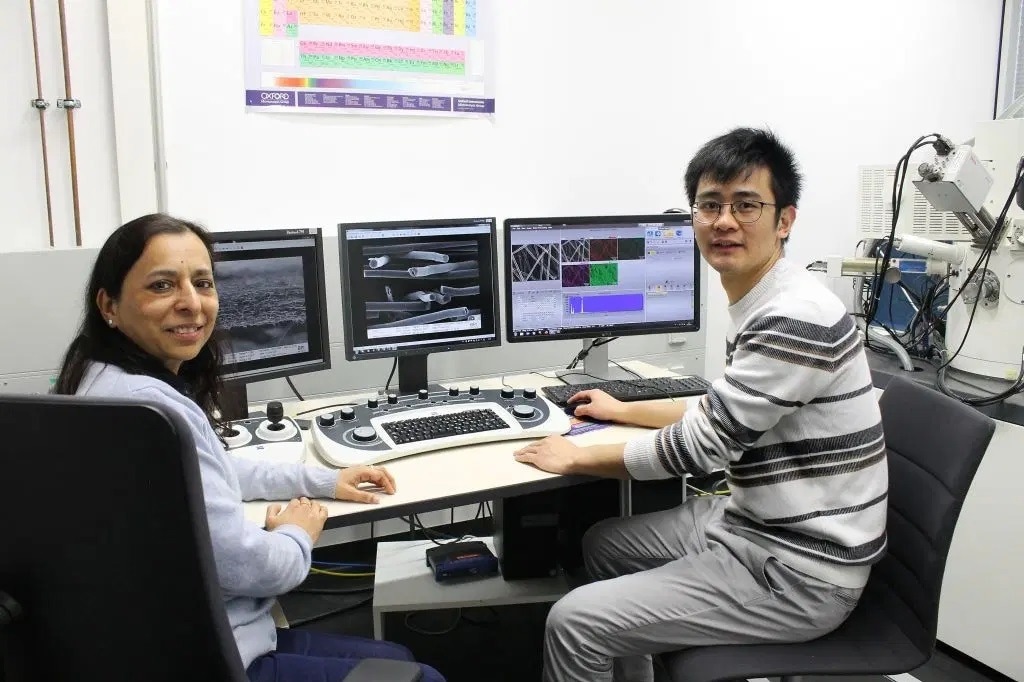At the University of Bayreuth, scientists present new electrospun nonwovens that display an exceptional combination of extremely low thermal conductivity and high electrical conductivity.

Professor Dr. Seema Agarwal (left) and Dr. Xiaojian Liao (right) analyzing scanning electron images of composite nonwovens consisting of carbon and ceramic
It is now feasible to decouple thermal and electrical conductivity with an easy-to-implement material idea.
The nonwovens are composed of carbon and silicon-based ceramic through the electrospinning process and are appealing for technological applications, for instance, in energy technology and electronics. They could be manufactured and processed profitably on an industrial scale.
Generally, high electrical conductivity has been linked to high thermal conductivity, and low thermal conductivity goes well with low electrical conductivity. But in several high-tech industries, there is an increasing interest in multifunctional materials that integrates good electricity along with low thermal transport.
Even though numerous strategies like conjugated polymers, dense inorganic materials, and alloys have been developed in the materials, obtaining extremely low thermal conductivity jointly with high electrical conductivity is still a huge difficulty for adaptable and foldable materials.
At the University of Bayreuth, the research group has found a ground-breaking idea for this difficulty to be addressed. New electrospun nonwovens are composed of silicon- and carbon-based ceramic and comprise fibers with a sea-island type nanostructure with a diameter ranging between 500 and 600 nm.
Every fiber comprises a matrix of carbon in which nano-sized ceramic phases are distributed homogeneously. The particles develop small “islands” in the “sea” of the carbon matrix and have opposite and complementary effects.
The presence of a carbon matrix enables electron transport in the fibers and hence high electrical conductivity, while the nano-sized silicon-based ceramic help prevent thermal energy from spreading just as easily.
This happens due to the interface present between the nano-sized ceramic and because the carbon matrix is extremely high, while the pores of the nonwoven appear to be very small. Consequently, there is a powerful scattering of phonons, which are considered to be the smallest physical units of vibrations activated by thermal energy. A constant directed heat flow does not happen.
The strange combination of extremely low thermal and high electrical conductivity currently has been emphasized by comparison with over 3,900 materials of all kinds, such as carbons, ceramics, natural materials, metals, glasses, synthetic polymers, and several composites. Electron transport and thermal energy insulation were highly coupled in the new electrospun composite fiber material compared to other materials.
Our electrospun nonwovens combine highly attractive multifunctional properties that are usually distributed among different classes of materials: high electrical conductivity, thermal insulation familiar from polymer foams, and non-flammability and heat resistance characteristic of ceramics.
Dr. Xiaojian Liao, Postdoctoral Researcher, Macromolecular Chemistry, University of Bayreuth
Liao added, “The fibers are based on a simple material concept, and they were made from commercial polymers.”
“We are convinced that our new fibers are suited for several application areas: for example, in the fields of energy management, battery-powered electromobility, smart textiles, or aerospace, ”stated Professor Dr. Seema Agarwal, professor of macromolecular chemistry at the University of Bayreuth and one of the corresponding authors of this new study.
At the University of Bayreuth, the interdisciplinary team with expertise in ceramics, polymers, physical chemistry, electrospinning, and electron microscopy, helped in making this work successful.
Interdisciplinary Collaboration on the Bayreuth Campus
Collaboration was made by various research centers for Bayreuth scientists in the development of the new material and the essential preliminary studies: the Bavarian Polymer Institute (BPI), the Bayreuth Center for Colloids and Interfaces (BZKG), the Bavarian Geoinstitute (BGI), and the Bavarian Center for Battery Technology (BayBatt).
Journal Reference
Liao, X., et al. (2023) Extremely low thermal conductivity and high electrical conductivity of sustainable carbonceramic electrospun nonwoven materials. Science Advances. doi.org/10.1126/sciadv.ade6066.